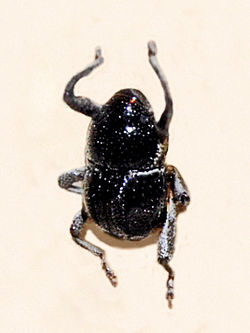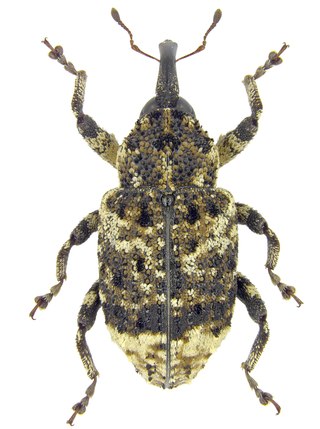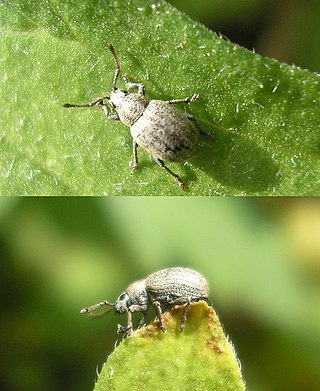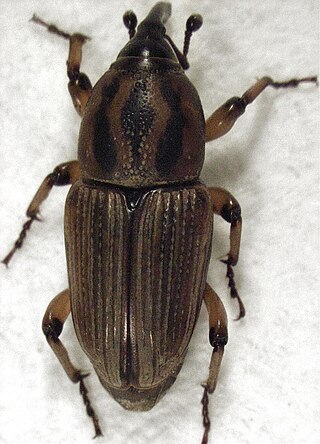| Asytesta | |
|---|---|
 | |
| Asytesta doriae | |
| Scientific classification | |
| Kingdom: | |
| Phylum: | |
| Class: | |
| Order: | |
| Family: | |
| Subfamily: | |
| Genus: | Asytesta Pascoe, 1865 |
| Synonyms | |
| |
Asytesta is a genus of beetles belonging to the family Curculionidae. [1] [2]
| Asytesta | |
|---|---|
 | |
| Asytesta doriae | |
| Scientific classification | |
| Kingdom: | |
| Phylum: | |
| Class: | |
| Order: | |
| Family: | |
| Subfamily: | |
| Genus: | Asytesta Pascoe, 1865 |
| Synonyms | |
| |
Asytesta is a genus of beetles belonging to the family Curculionidae. [1] [2]
Species within this genus include: [3]

Brentidae, sometimes known as the primitive weevils, is a cosmopolitan family of primarily xylophagous beetles also known as straight-snouted weevils. The concept of this family has been expanded with the inclusion of three groups formerly placed in the Curculionidae; the subfamilies Apioninae, Cyladinae, and Nanophyinae, as well as the Ithycerinae, previously considered a separate family. They are most diverse in the tropics, but occur throughout the temperate regions of the world. They are among the families of weevils that have non-elbowed antennae, and tend to be elongate and flattened, though there are numerous exceptions.

Cryptorhynchinae is a large subfamily of weevils (Curculionidae), with some 6000 species. They are found in most zoogeographic regions although they are most diverse in the Neotropics, Australia and Oceania.

Gymnopholus is a genus of beetles in the family Curculionidae occurring in New Guinea. Many of them are notable for the growth of algae, diatoms, fungi, lichens and mosses on their backs(especially the subgenus Symbiopholus). The genus is divided into two subgenera and contains the following species:

Otiorhynchus is a large genus of weevils in the family Curculionidae. Many species of the genus, particularly the black vine weevil and the strawberry root weevil, are important pests, both as larvae and as adults. Larvae feed on plant roots. Adults are flightless with fused elytra and feed at night on plant foliage. In many species of the genus at least some races are polyploid and parthenogenetic, while the rest of the races and species are diploid and bisexual. Otiorhynchus weevils, particularly O. scaber, have been a popular subject for studies of the evolution of parthenogenesis. The genus is native to the Palearctic region. However, sixteen species were inadvertently introduced to North America and have become widespread there.
Orchidophilus is a genus of true weevils in the subfamily Baridinae. There are six species. These weevils live in orchids, and are known generally as orchid weevils. They are native to Indonesia, the Philippines, and surrounding islands, and they can sometimes be found in shipments of cultivated orchids. Two species, Orchiophilus aterrimus and O. perigrinator, are pests of orchids that have become naturalized outside their native range.

Entimus is a genus of broad-nosed weevils belonging to the family true weevil and the Entiminae subfamily.

Ceutorhynchini is a true weevil tribe in the subfamily Baridinae.

Entimini is a Neotropical weevil tribe in the subfamily Entiminae that includes 46 described species.

Peritelini is a weevil tribe in the subfamily Entiminae.

Asytesta doriae is a species of beetles belonging to the family Curculionidae.

Scolopterus is a genus of weevils from the family Curculionidae. This genus was first described by Adam White in 1846. The type species for this genus is Scolopterus tetracanthus White, 1846 by original designation. Species from this genus are found in New Zealand.

Pandeleteius is a genus of broad-nosed weevils in the family Curculionidae. There are over 150 described species in Pandeleteius, distributed across the Americas. Most species in the genus were described by Anne Howden.
Sicoderus tinamus is a species of true weevil in the beetle family Curculionidae. It is found in North America.

Sicoderus is a genus of true weevils in the beetle family Curculionidae. There are more than 75 described species in Sicoderus.
Rhynchus is a genus of hidden snout weevils in the family of beetles known as Curculionidae. There is at least one described species in Rhynchus, R. apiculatus.
Isodacrys is a genus of broad-nosed weevils in the beetle family Curculionidae. There are 20 described species in Isodacrys, ranging from the southern United States of America to Honduras.
Rhinostomus frontalis is a species of weevils, previously placed in a genus called Yuccaborus and known as the yucca weevils.

Brachyolus is a genus of broad-nosed weevil in the family Curculionidae.

Sphenophorus brunnipennis is a beetle in the Dryophthoridae family.

Polyteles is a South American genus of broad-nosed weevils in the subfamily Entiminae, tribe Entimini. There are seven described species distributed in Argentina, Bolivia, Brazil, Ecuador, Paraguay, Peru, and Uruguay.